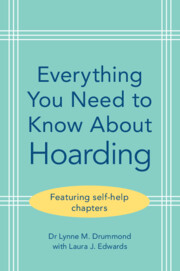Book contents
- Everything You Need to Know About Hoarding
- Reviews
- Everything You Need to Know About Hoarding
- Copyright page
- Contents
- Preface
- 1 Introduction
- 2 When Does Hoarding Arise?
- 3 Hoarding Disorder
- 4 Animal Hoarding
- 5 Obsessive Compulsive Disorder, Obsessive Compulsive Personality Disorder, Hoarding Disorder, and How They Interact
- 6 Hoarding in People with Attention Deficit Hyperactivity Disorder, Autism, and Impulse Control Issues
- 7 Treatment of Hoarding Disorder: Medication
- 8 Treatment of Hoarding Disorder: Psychological Approaches
- 9 What About the Law and Hoarding?
- 10 How Can Someone with Hoarding Disorder Help Themselves?
- 11 What Can You Do to Help a Friend or Relative Who Has Hoarding Disorder or Hoarding Symptoms?
- Clutter Image Rating
- Glossary
- Resources
- Further Reading
- Notes
- Index
- References
10 - How Can Someone with Hoarding Disorder Help Themselves?
Published online by Cambridge University Press: 10 April 2025
- Everything You Need to Know About Hoarding
- Reviews
- Everything You Need to Know About Hoarding
- Copyright page
- Contents
- Preface
- 1 Introduction
- 2 When Does Hoarding Arise?
- 3 Hoarding Disorder
- 4 Animal Hoarding
- 5 Obsessive Compulsive Disorder, Obsessive Compulsive Personality Disorder, Hoarding Disorder, and How They Interact
- 6 Hoarding in People with Attention Deficit Hyperactivity Disorder, Autism, and Impulse Control Issues
- 7 Treatment of Hoarding Disorder: Medication
- 8 Treatment of Hoarding Disorder: Psychological Approaches
- 9 What About the Law and Hoarding?
- 10 How Can Someone with Hoarding Disorder Help Themselves?
- 11 What Can You Do to Help a Friend or Relative Who Has Hoarding Disorder or Hoarding Symptoms?
- Clutter Image Rating
- Glossary
- Resources
- Further Reading
- Notes
- Index
- References
Summary
In this chapter we examine how people with Hoarding disorder can help themselves. This is not a “quick fix” and does take time, commitment, and courage to face up to your problems. We will start by looking at how a ban on new items coming into the property is the first “golden rule” of treatment. We will examine how it can be useful but not essential to have a friend or family member also involved in the process. The principles of discarding objects are discussed with the idea of holding on to objects for the shortest time possible, making an immediate decision and then sticking with it and not going back on that decision. Finally, we will then list helpful resources and groups who may be able to assist you.
Information
- Type
- Chapter
- Information
- Everything You Need to Know About Hoarding , pp. 145 - 164Publisher: Cambridge University PressPrint publication year: 2025
